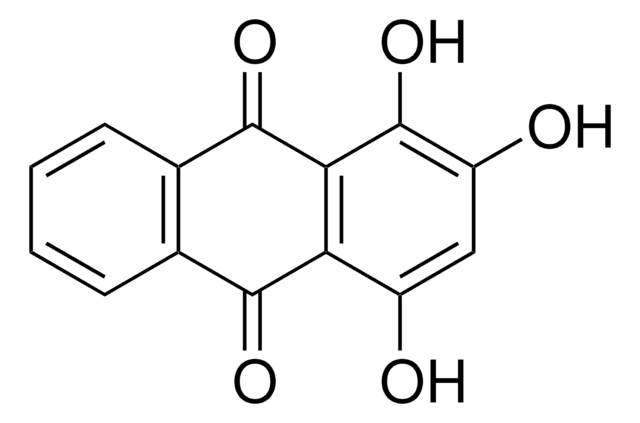S4503
DL-Serine hydroxamate
≥97% (TLC), suitable for ligand binding assays
Synonym(s):
SHX
Sign Into View Organizational & Contract Pricing
All Photos(3)
About This Item
Empirical Formula (Hill Notation):
C3H8N2O3
CAS Number:
Molecular Weight:
120.11
MDL number:
UNSPSC Code:
12352209
PubChem Substance ID:
NACRES:
NA.26
Recommended Products
product name
DL-Serine hydroxamate, seryl-tRNA synthetase inhibitor
Assay
≥97% (TLC)
form
powder
technique(s)
ligand binding assay: suitable
color
white to off-white
application(s)
cell analysis
storage temp.
−20°C
SMILES string
NC(CO)C(=O)NO
InChI
1S/C3H8N2O3/c4-2(1-6)3(7)5-8/h2,6,8H,1,4H2,(H,5,7)
InChI key
LELJBJGDDGUFRP-UHFFFAOYSA-N
Application
Serine has been used as an inhibitor of seryl-tRNA synthetase. DL-Serine hydroxamate is used to induce metabolic synthesis of guanosine 3′-diphosphate 5′-diphosphate (ppGpp) in E. coli by amino acid starvation. It is also used to synchronize cell cycle in E. coli cultures by inhibition of tRNA charging.
Biochem/physiol Actions
Serine is involved in the one-carbon unit metabolism. It is associated with the biosynthesis of cysteine, ceramide, phosphatidylserine, purine and pyrimidine. In bacteria, it participates in tryptophan synthesis. Gluconeogenesis, one of the important biochemical processes, involves serine, particularly in ruminants. Protein phosphorylation is one such event that utilizes serine. Glycine, a metabolic product of serine, serves as an antioxidant and a neurotransmitter. D-serine is known to activate the N-methyl-D-aspartate (NMDA) receptors of the brain. Serine hydroxamate, a structural analogue of serine prevents seryl-tRNA (transfer ribonucleic acid) charging and thereby decreases phospholipid and nucleic acid synthesis in Escherichia coli.
Storage Class Code
11 - Combustible Solids
WGK
WGK 3
Flash Point(F)
Not applicable
Flash Point(C)
Not applicable
Personal Protective Equipment
dust mask type N95 (US), Eyeshields, Gloves
Certificates of Analysis (COA)
Search for Certificates of Analysis (COA) by entering the products Lot/Batch Number. Lot and Batch Numbers can be found on a product’s label following the words ‘Lot’ or ‘Batch’.
Already Own This Product?
Find documentation for the products that you have recently purchased in the Document Library.
C van Delden et al.
Journal of bacteriology, 183(18), 5376-5384 (2001-08-22)
During nutrient starvation, Escherichia coli elicits a stringent response involving the ribosome-associated protein RelA. Activation of RelA results in a global change in the cellular metabolism including enhanced expression of the stationary-phase sigma factor RpoS. In the human pathogen Pseudomonas
D Riesenberg et al.
Journal of general microbiology, 130(10), 2549-2558 (1984-10-01)
The accumulation of RNA and protein and the kinetics of nucleoside triphosphate and guanosine polyphosphate pools during amino acid starvation and carbon source downshift were investigated in Streptomyces hygroscopicus. RNA accumulation was controlled stringently during both amino acid starvation and
M P Patricelli et al.
Proteomics, 1(9), 1067-1071 (2002-05-07)
The field of biochemistry is currently faced with the enormous challenge of assigning functional significance to more than thirty thousand predicted protein products encoded by the human genome. In order to accomplish this daunting task, methods will be required that
David L Erickson et al.
Infection and immunity, 72(10), 5638-5645 (2004-09-24)
The stringent response is a mechanism by which bacteria adapt to nutritional deficiencies through the production of the guanine nucleotides ppGpp and pppGpp, produced by the RelA enzyme. We investigated the role of the relA gene in the ability of
H J Cha et al.
Applied and environmental microbiology, 65(2), 409-414 (1999-01-30)
We constructed and characterized three stress probe plasmids which utilize a green fluorescent protein as a noninvasive reporter in order to elucidate Escherichia coli cellular stress responses in quiescent or resting cells. Cellular stress levels were easily detected by fusing
Our team of scientists has experience in all areas of research including Life Science, Material Science, Chemical Synthesis, Chromatography, Analytical and many others.
Contact Technical Service







